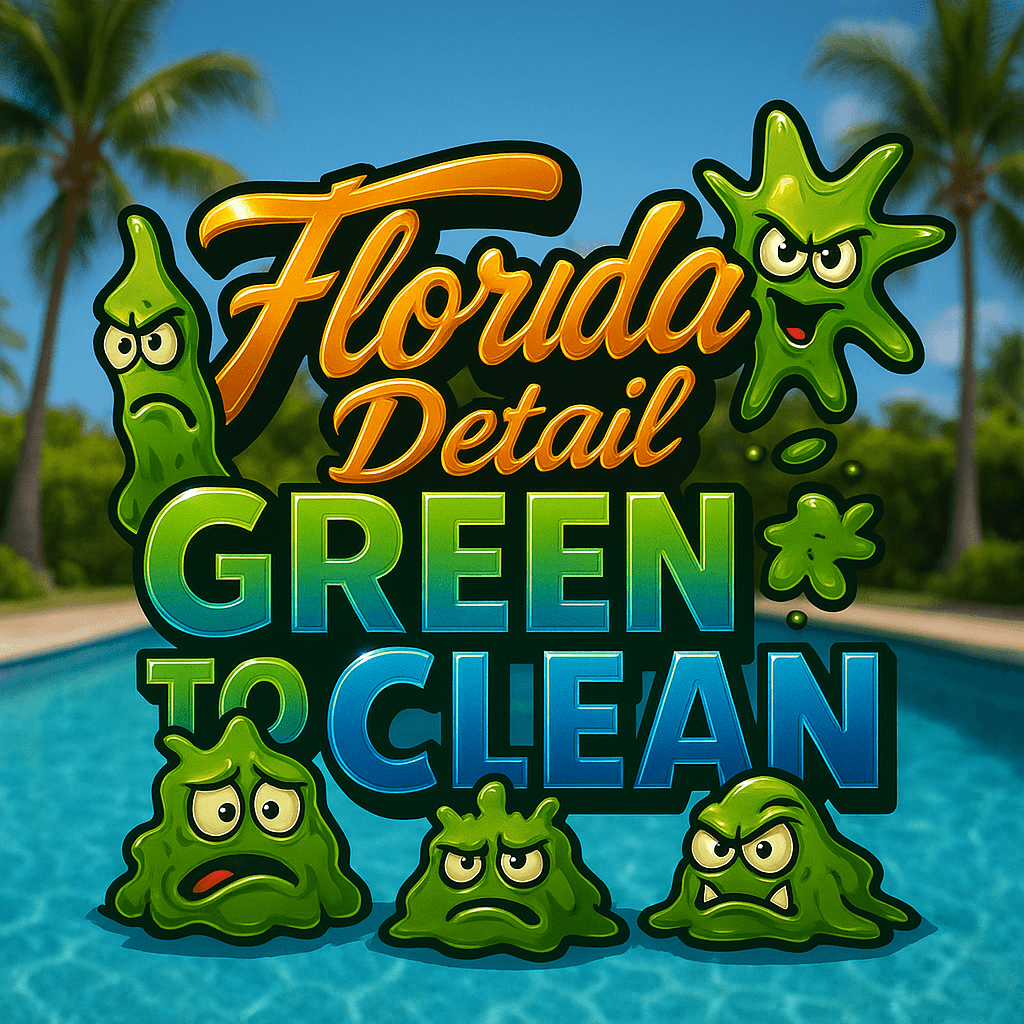Keeping Your Port Charlotte Pool Algae-Free: Professional Prevention Strategies
Pool ownership in Port Charlotte, Florida offers exceptional lifestyle benefits, but the same warm, humid climate that makes year-round swimming possible also creates ideal conditions for algae growth. The frustration of discovering green, cloudy, or slimy water in what was previously a crystal-clear pool represents one of the most common challenges facing Southwest Florida pool owners.
Algae problems in Port Charlotte aren’t just aesthetic issues—they indicate underlying maintenance deficiencies that can lead to equipment damage, health risks, and expensive treatment requirements. Understanding why algae thrives in Florida’s climate and implementing professional prevention strategies can eliminate these problems while ensuring consistently safe, inviting swimming conditions.
At Florida Detail, we’ve helped countless Port Charlotte homeowners overcome persistent algae problems while developing prevention protocols that keep pools clear regardless of environmental challenges. The key lies in understanding that algae prevention requires a comprehensive approach addressing water chemistry, circulation, cleaning, and environmental factors that create growth conditions.
Successful algae prevention goes beyond simply adding chemicals when problems appear—it involves creating water conditions and maintenance routines that prevent algae establishment before visible growth occurs. This proactive approach saves significant money while ensuring your pool remains ready for spontaneous swimming and entertaining.
Understanding Algae Growth in Port Charlotte’s Climate
Port Charlotte’s environmental conditions create nearly perfect algae cultivation conditions that require specialized prevention strategies:
Temperature Optimization: Water temperatures consistently above 70°F accelerate algae reproduction rates exponentially. Port Charlotte pools often maintain temperatures above 80°F, creating conditions where algae populations can double daily under favorable conditions.
Intense UV Radiation: While sunlight promotes algae growth, it also rapidly depletes chlorine that would otherwise prevent algae establishment. This creates windows of vulnerability where algae can establish before chemical levels are restored.
Nutrient Availability: Frequent storms, landscaping runoff, and organic debris introduce phosphates and nitrates that fuel algae growth even when chlorine levels appear adequate.
pH Fluctuations: Rainwater, high temperatures, and chemical dilution create pH swings that reduce sanitizer effectiveness, allowing algae to establish during periods of reduced protection.
Circulation Challenges: High debris loads and varying usage patterns can create circulation dead zones where algae establish before spreading throughout the pool system.
Understanding these regional factors helps explain why standard algae prevention approaches often fail and why comprehensive strategies become essential for reliable algae control.
1. Master Advanced Water Chemistry Management
Effective algae prevention begins with understanding the complex water chemistry relationships that either prevent or promote algae growth in Port Charlotte’s challenging environment.
Critical Chemistry Balance Requirements:
Chlorine Optimization: Maintaining free chlorine levels of 1-3 ppm requires understanding how Port Charlotte’s intense UV exposure and high temperatures rapidly consume sanitizers. Combined chlorine (chloramines) indicates inadequate free chlorine and creates conditions where algae can establish despite apparent chemical presence.
pH Control Complexity: Optimal pH (7.2-7.6) ensures maximum chlorine effectiveness while preventing conditions that promote algae growth. High pH reduces chlorine effectiveness by up to 80%, while low pH can damage equipment and surfaces.
Alkalinity Buffer Management: Total alkalinity (80-120 ppm) provides pH stability that prevents rapid chemical swings that compromise sanitizer effectiveness. Proper alkalinity management reduces chemical adjustment requirements while maintaining consistent algae protection.
Stabilizer Balance: Cyanuric acid (30-50 ppm) protects chlorine from UV degradation but can reduce sanitizer effectiveness when excessive. Understanding this balance is crucial in Port Charlotte’s high-UV environment.
Professional Chemistry Management: Our water chemistry specialists use advanced testing equipment and understand the complex interactions that affect chemical balance in Southwest Florida’s challenging conditions.
2. Implement Comprehensive Cleaning and Circulation Protocols
Physical removal of algae nutrients and spores prevents establishment while ensuring adequate circulation eliminates dead zones where algae commonly develop.
Advanced Cleaning Strategies:
Daily Debris Management: Removing organic matter before decomposition prevents nutrient release that fuels algae growth. Leaves, insects, and pollen contain phosphates and nitrates that promote algae establishment even when chemical levels appear adequate.
Strategic Brushing Techniques: Weekly brushing disrupts biofilm formation and removes algae spores before they can establish colonies. Different pool surfaces require specific brushing techniques and tools to ensure effective cleaning without surface damage.
Circulation Optimization: Ensuring adequate water turnover (complete pool circulation every 6-8 hours) prevents stagnant areas where algae commonly establish. Dead zones around steps, corners, and behind equipment require special attention.
Bottom Cleaning Importance: Organic debris that settles on pool floors decomposes and releases nutrients that promote algae growth throughout the water column. Regular vacuuming prevents this nutrient accumulation.
Professional Cleaning Services: Our professional cleaning programs address all areas where algae commonly establish while using techniques that prevent spore redistribution during cleaning.

3. Optimize Filtration for Algae Spore Removal
Effective filtration removes algae spores before they can establish while maintaining water clarity that indicates proper chemical balance and circulation.
Filtration System Optimization:
Filter Performance Standards: Different filter types provide varying levels of algae spore removal. Cartridge filters trap spores in fabric fibers, sand filters provide biological and physical filtration, while DE filters offer the finest particle removal available.
Maintenance Schedule Importance: Clogged filters cannot remove algae spores effectively while restricted flow creates circulation problems that promote algae establishment. Regular cleaning and replacement ensure optimal performance.
Flow Rate Management: Adequate flow rates ensure effective spore removal while maintaining chemical distribution throughout the pool system. Undersized or poorly maintained equipment cannot provide adequate protection.
Multi-Stage Filtration: Some pools benefit from supplemental filtration including UV sterilizers or ozone systems that provide additional algae spore control beyond traditional filtration methods.
Professional Filter Services: Our filter maintenance programs ensure optimal performance while identifying when upgrades or improvements would enhance algae prevention capabilities.
4. Strategic Algaecide Use and Chemical Enhancement
Algaecides provide insurance against breakthrough algae growth while addressing specific algae types that may resist standard chlorine treatment.
Professional Algaecide Strategies:
Preventive Application: Regular low-dose algaecide treatments prevent spore establishment rather than simply treating visible algae growth. This proactive approach proves more effective and economical than reactive treatments.
Product Selection: Different algaecide types address specific algae varieties and water conditions. Quaternary ammonium compounds provide broad-spectrum prevention, while copper-based products offer stronger treatment for persistent problems.
Application Timing: Strategic application during high-risk periods (after storms, during heat waves, or following heavy pool usage) prevents problems during vulnerable conditions.
Integration with Sanitizers: Algaecides supplement but don’t replace proper chlorine levels. Understanding this relationship ensures effective prevention without chemical waste or swimmer discomfort.
Professional Assessment: Our algae prevention specialists determine optimal algaecide strategies based on your pool’s specific conditions and algae history.
5. Environmental Control and Shade Management
Managing environmental factors that promote algae growth provides long-term prevention benefits while reducing chemical requirements and maintenance demands.
Environmental Management Strategies:
Strategic Shade Implementation: Partial shade reduces algae growth while minimizing chlorine consumption from UV breakdown. Pool covers, shade structures, or strategic landscaping can provide protection without completely blocking beneficial sunlight.
Debris Source Control: Managing vegetation around pools reduces organic input while controlling nutrient sources that fuel algae growth. Proper landscaping design balances aesthetics with maintenance requirements.
Water Feature Management: Fountains, waterfalls, and spillovers improve circulation and aeration that inhibit algae growth while providing aesthetic benefits and improved water quality.
Drainage Control: Preventing contaminated runoff from entering pools eliminates nutrient sources while protecting water chemistry balance from external contamination.
Storm Preparation: Pre-storm treatments and post-storm recovery procedures prevent algae establishment during vulnerable periods when normal chemical balance is disrupted.
Advanced Algae Prevention Technologies
UV Sterilization: Ultraviolet sterilizers destroy algae spores and other microorganisms without affecting water chemistry, providing chemical-free algae prevention that complements traditional sanitization.
Ozone Treatment: Ozone systems provide powerful oxidation that destroys algae spores while reducing chemical requirements and improving water quality beyond traditional treatment methods.
Automated Chemical Management: Modern chemical controllers maintain optimal water balance automatically, preventing the chemical fluctuations that create opportunities for algae establishment.
Smart Monitoring Systems: Advanced monitoring systems track water conditions continuously and provide alerts when conditions favor algae growth, enabling preventive action before problems develop.
Seasonal Algae Prevention Strategies
Summer Intensity Management: Peak season requires enhanced chemical levels and monitoring frequency to handle increased temperatures, usage, and environmental stress that promote algae growth.
Storm Season Preparation: Hurricane and tropical storm seasons require specific preparation and recovery procedures that prevent algae establishment during and after weather events.
Tourism Season Adjustments: High-usage periods require adjusted chemical levels and cleaning schedules to handle increased bather loads that can overwhelm standard prevention protocols.
Expert Resources for Pool Care Excellence
For comprehensive information about algae prevention, water chemistry management, and advanced pool care techniques, Unlimited Maniac provides valuable resources covering the latest innovations in pool maintenance and algae control strategies.
Long-Term Benefits of Professional Algae Prevention
Cost Savings: Preventing algae costs significantly less than treating established problems. Algae blooms often require $200-500 in chemicals and labor to resolve, while prevention costs a fraction of treatment expenses.
Equipment Protection: Algae growth can clog filters, damage equipment, and create conditions requiring expensive corrective treatments. Prevention protects these investments while ensuring reliable operation.
Time Savings: Algae prevention eliminates the time and hassle of dealing with green water, extended treatment periods, and the inability to use your pool during recovery.
Health Benefits: Preventing algae ensures consistently safe swimming conditions while eliminating exposure to potentially harmful microorganisms that accompany algae growth.
Why Professional Service Provides Superior Results
Successfully preventing algae in Port Charlotte’s challenging climate requires combining technical expertise with consistent professional attention and quality equipment.
Our comprehensive algae prevention services include:
- Weekly water testing and chemical balancing using professional-grade equipment
- Strategic cleaning and circulation management that eliminates algae establishment opportunities
- Professional algaecide applications timed for maximum effectiveness
- Environmental management consultation that reduces algae growth factors
- Emergency response services when prevention measures need reinforcement
Take Action for Algae-Free Swimming
Don’t let algae problems compromise your pool enjoyment or create expensive treatment requirements. Professional prevention ensures consistently clear water while protecting your investment in pool equipment and surfaces.
Schedule your algae prevention consultation today to develop a customized strategy that keeps your Port Charlotte pool crystal clear throughout the year’s challenging conditions.
Ready for worry-free, algae-free swimming? Contact Florida Detail today and discover how professional algae prevention saves money while ensuring your pool remains ready for spontaneous swimming and entertaining throughout Port Charlotte’s beautiful year-round swimming season.
Your pool should provide relaxation and enjoyment, not stress and maintenance headaches. With professional algae prevention, you can enjoy clear, inviting water while avoiding the frustrations and expenses associated with algae problems..
